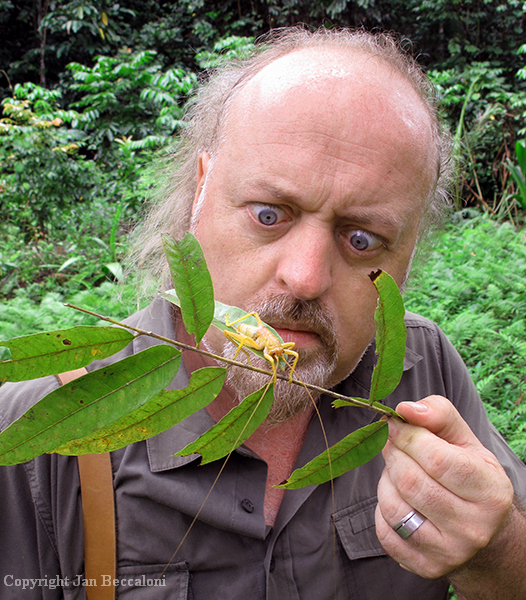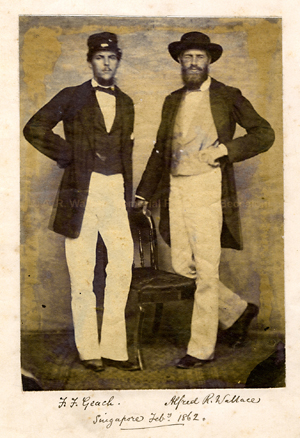An Appreciation of Wallace's Book 'The Malay Archipelago'
By Bill Bailey (Patron of the Wallace Memorial Fund)

Over the last twenty years I’ve travelled extensively through the countries that used to be known as The Malay Archipelago. This book was, for me, required reading during these many adventures. Often these would involve long treks through the jungles of Malaysian Borneo and Indonesia in similar kinds of conditions to those that Wallace encountered. Except that unlike Wallace, we had the benefit of air travel, sunblock, insect repellent, anti-malarials, water purification tablets, lightweight breathable fabrics, mobile phones and all manner of modern accoutrements to combat the heat, the biting insects and to assist in the mere business of getting around in these tropical latitudes.
This is where I began to develop my deep admiration for Alfred Russel Wallace. My education about his immense contribution to our understanding of nature came later. It was experiencing for myself a little of the same hardship he suffered that showed me the measure of the man. Not only this, but the fact he was travelling for the most part alone, without any European companionship. My treks have all been with a group of friends, and when the going gets tough, the importance of others to encourage and support you cannot be overstated.
Some of the exotic locations that Wallace describes in the book are even today, difficult to reach even with the benefit of modern travel. Places like the Aru Islands, in the south-eastern part of the Moluccas are so remote, so inaccessible that even Sir David Attenborough has yet to reach them. And I would imagine he’s been to every corner of the planet.

While I was filming a documentary about Wallace, I was lucky enough to have a first edition of the book, which I consulted every day. Far from being of some symbolic value, a reminder of Wallace that I carried merely as a talisman, it frequently had real, practical value. It was a daily marvel to me how this book first published in 1869 was still so wonderfully useful. When I was wading through a fast-flowing river on the island of Halmahera, my local guide saw a deer. The word he used for it was not that commonly used in Bahasa Indonesia, the national language of the country, but a regional variation. A quick leaf through The Malay Archipelago, and there in the appendix I found the word among Wallace’s scrupulous annotations of local dialects. That was one of many moments when the book seemed to compress time, to shoot forward in to the present, to bring Wallace’s character right there alongside me.
The incidental detail of his epic journey is always rendered with wit and keen observation. His description of eating a durian, the highly scented fruit favoured by tigers and orangutans, has never been bettered. He writes that the taste resembled "rich custard highly flavoured with almonds’ plus ‘occasional wafts of flavour that call to mind cream-cheese, onion-sauce, sherry-wine, and other incongruities."
The book not only reveals Wallace’s incessant curiosity about the flora and fauna, it shows an equal interest in the indigenous peoples of the regions. I enjoyed his eloquent reflections on tribal culture, where he defends these peoples, dismissed by his peers as ‘savages’ as in fact being more civilized than members of Victorian society. He writes with great clarity in a modest and understated way that belies the physical hardship he endured, the loneliness and isolation.
It is a terrific read, at once exciting and informative, one minute providing historical context, the next some practical advice on language. Immersing yourself in The Malay Archipelago is as close as you can get to being a travelling companion with perhaps the greatest field naturalist the world has ever seen. You’ll encounter bugs and reptiles and orangutans, and pirates and tsunamis and dazzling exotic birds of paradise. It is simply one of the greatest travelogues ever written. Whether you are ever fortunate enough to travel in Wallace’s footsteps or not, this remarkable account of 19th century discovery appeals to the adventurer in us all.
Beautifully written and illustrated, shot through with passionate admiration for the natural world, it is one man’s epic voyage, often into the unknown. To read it, is to relive this adventure, to walk in his footsteps, and to experience one man’s journey that led him to perhaps the greatest discovery in Science, evolution by Natural Selection.

Watercolour of Wallace’s Flying Frog from Sarawak,
painted by Wallace in 1855
*******************************************
This article was first published on the This Folio Life blog in the April 2017.
For information about the Folio Society's recently published 'deluxe' edition of Wallace's classic book The Malay Archipelago CLICK HERE
